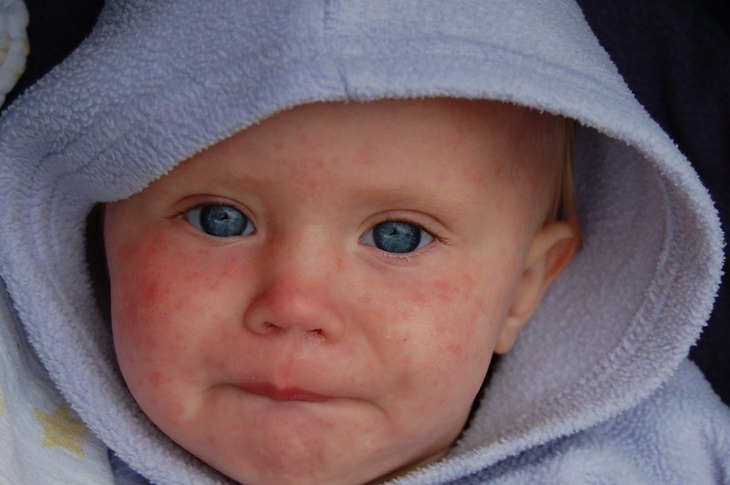1. Measles
Measles is a highly contagious infection caused by the Measles morbillivirus. It manifests itself through a sore throat, cough, fever, red eyes, and a tell-tale rash that covers the entire body. But before these first symptoms appear, the person is already contagious for 4 days and could be unknowingly infecting people. This explains why so many recent outbreaks have occurred in close-knit communities, mostly in areas where the MMR vaccination that stops the virus is unavailable or vaccinations are declined.
In recent years, measles has reemerged in many countries, including those where it was believed to be eliminated like the USA and certain European countries. The biggest measles outbreak since 1992 occurred in the US in 2019, with 1249 measles cases reported, 89% of which have occurred in unvaccinated individuals.
Unfortunately, measles isn’t the harmless flu-like condition many people believe it to be; studies point out that it is a leading cause of mortality in children below the age of 5. Survivors of measles, especially children, may deal with complications like deafness, vision loss, and brain damage.
2. Mumps
Mumps is another one of those highly transmissible diseases that’s actually still quite common both in the US and abroad. Even though vaccinations and quarantine regulations usually help limit outbreaks of mumps, there are still thousands of cases reported in the USA every year.
The majority of these outbreaks occur at schools, colleges, and military posts, or any other place where a large population works and lives together. Community-related and workplace-related outbreaks are also occasionally recorded.
Like measles, mumps is contagious for days and sometimes weeks before symptoms occur. The condition starts with flu-like symptoms. Over the next two days, there's swelling in one or both of the salivary glands, which restricts movement of the neck and makes swallowing painful. Most people recover from mumps, but complications are common and sometimes severe. These include hearing loss, meningitis, encephalitis, miscarriage, and severe testicular pain that could result in testicular atrophy.
3. Plague
What previous generations all defined as the plague is in reality three different types of the same disease caused by the Yersinia pestis bacterium. They are the bubonic, septicemic, and pneumonic plagues. The infamous Black Death that claimed the lives of 200 million people in 14th-century Europe and North Africa was caused by the bubonic plague, the least deadly of the three.
If left untreated, 30-60% of bubonic plague patients die, but the mortality rates of both the septicemic and the pneumonic plague varieties are almost total and sometimes occur on the same day a person is presented with symptoms. Despite all the medical efforts to eradicate these deadly and terrifying illnesses, small outbreaks of the plague are recorded worldwide every year.
In recent years, most plague cases occurred in the Democratic Republic of Congo and Madagascar. But according to the CDC, 1-17 people are diagnosed with bubonic or septicemic plague in the United States annually. The disease is spread through flea bites, infected rodents, or contact with dead animals.
Patients first develop a fever, malaise, and painful and swollen lymph nodes. Urgent antibiotic treatment is essential in any suspected cases, but if caught too late, nothing can be done to stop this deadly illness.
4. Scurvy
Scurvy is known as the disease plaguing (pardon the pun) sailors too long at sea. However, even we land people can easily develop it today. The condition manifests itself through bruising and bleeding around the hair follicles on the body, bleeding and swollen gums, tooth loss, and impaired wound healing. These symptoms can develop just after a few months of a vitamin C deficient diet.
If you eat plenty of fruit and vegetables, you’re very unlikely to develop a vitamin C deficiency. But access to fresh produce is not a given, even in developed countries like the UK and the US. In fact, as many as 17% of the low-income population in the US suffer from scurvy according to a 2009 report by the CDC. A vitamin C supplement can fix the symptoms of scurvy very fast, but unfortunately, the condition is often misdiagnosed, as even many doctors believe it to be rarer than it really is.
This disease was known to haunt sailors because it is hard to keep produce on a ship for months, and there's usually a shortage of these types of foods on long trips.
5. Typhoid
You may be familiar with typhoid fever as the disease that terrorized America in the 19th and 20th centuries. The story of Typhoid Mary, an asymptomatic cook who unknowingly spread the disease to 50 people in New York City, became infamous, but we often dismiss this cautionary tale as outdated. Meanwhile, typhoid fever continues to be a major health concern in many regions of the world.
But what is typhoid fever? To put it simply, it is a bacterial infection caused by Salmonella typhi. Ingesting food and water contaminated by the bacterium develop high fever and diarrhea that evolve into delirium and death, if left untreated. Antibiotics are effective at eliminating the bacterium, and hygienic practices and water clarification help prevent the spread of the disease.
But with the rising problems of access to clean water in many areas of the world and antibiotic resistance make it a bigger threat than you’d think. In fact, almost 6,000 cases of typhoid fever are recorded every year in the US. 75% of American typhoid patients got the vaccine overseas. So, if you’re planning on traveling abroad to a high-risk area, a typhoid vaccination is highly recommended.
6. Leprosy
What do you know about leprosy? Most people are vaguely familiar with the practice of isolating those afflicted by leprosy on islands or other remote areas. And make no mistake, leprosy colonies are not only a Medieval practice. The infamous Kalaupapa leprosy colony in Hawaii is home to a group of people who were exiled there in the 1960s even today. As for the disease itself, it’s also alive and kicking, despite global attempts at eradicating the disease.
In the US, 100-200 new cases of leprosy are diagnosed every year and thousands of people suffering from the disease live in the US. But you wouldn’t know that because it was renamed as Hansen’s disease due to the negative social connotation.
Leprosy is a mycobacterial infection caused by M. leprae and M. lepromatosis that damages the nervous system, the skin, the respiratory system. It often attacks the eyes and the nose, and it can be badly disfiguring. Untreated, Hansen’s disease results in irreversible nerve damage, limb paralysis, and blindness. Luckily, the ailment responds well to treatment and renders those affected by it not contagious. Helpful fact: you could get leprosy from armadillos, which carry the disease.
7. Syphilis
Some of the most famous historical figures had this disease: Henry VIII, Oscar Wilde, Vincent van Gogh, Christopher Columbus, Abraham Lincoln, and Leo Tolstoy are just a few names on that list. Even though antibiotic treatment dramatically reduced its spread all around the world, the creepy STD is actually on the rise.
Data from the World Health Organization suggests that 6.3 million new cases of syphilis are recorded annually. The symptoms of this infection caused by the Treponema pallidum bacterium vary from person to person, which makes it difficult to diagnose. In some people, symptoms only appear 90 days after exposure and could be hardly noticeable: a painless rash in the mouth or the nether regions, fever, and fatigue.
These symptoms can worsen fast and result in paralysis and organ damage. Alternatively, they stay dormant for decades, but in that time, the person will be able to transmit the disease to others. Early diagnosis, treatment, and STD awareness are the best methods of fighting this disease.
Share this information with those interested in medicine and health!
 Go to BabaMail
Go to BabaMail



























































